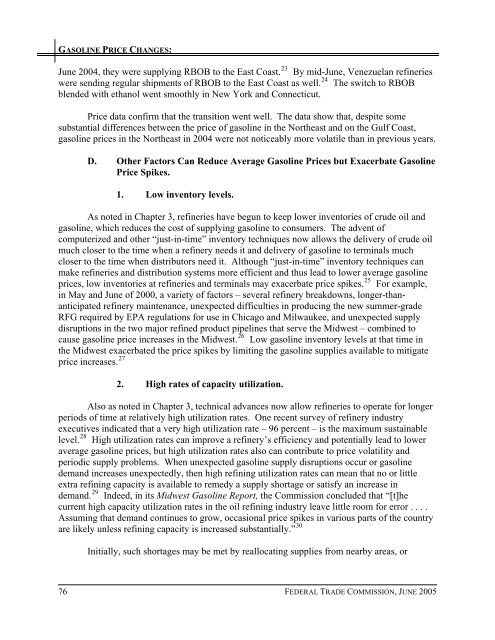Gasoline Price Changes - Federal Trade Commission
Gasoline Price Changes - Federal Trade Commission
Gasoline Price Changes - Federal Trade Commission
You also want an ePaper? Increase the reach of your titles
YUMPU automatically turns print PDFs into web optimized ePapers that Google loves.
GASOLINE PRICE CHANGES:<br />
June 2004, they were supplying RBOB to the East Coast. 23 By mid-June, Venezuelan refineries<br />
were sending regular shipments of RBOB to the East Coast as well. 24 The switch to RBOB<br />
blended with ethanol went smoothly in New York and Connecticut.<br />
<strong>Price</strong> data confirm that the transition went well. The data show that, despite some<br />
substantial differences between the price of gasoline in the Northeast and on the Gulf Coast,<br />
gasoline prices in the Northeast in 2004 were not noticeably more volatile than in previous years.<br />
D. Other Factors Can Reduce Average <strong>Gasoline</strong> <strong>Price</strong>s but Exacerbate <strong>Gasoline</strong><br />
<strong>Price</strong> Spikes.<br />
1. Low inventory levels.<br />
As noted in Chapter 3, refineries have begun to keep lower inventories of crude oil and<br />
gasoline, which reduces the cost of supplying gasoline to consumers. The advent of<br />
computerized and other “just-in-time” inventory techniques now allows the delivery of crude oil<br />
much closer to the time when a refinery needs it and delivery of gasoline to terminals much<br />
closer to the time when distributors need it. Although “just-in-time” inventory techniques can<br />
make refineries and distribution systems more efficient and thus lead to lower average gasoline<br />
prices, low inventories at refineries and terminals may exacerbate price spikes. 25 For example,<br />
in May and June of 2000, a variety of factors – several refinery breakdowns, longer-thananticipated<br />
refinery maintenance, unexpected difficulties in producing the new summer-grade<br />
RFG required by EPA regulations for use in Chicago and Milwaukee, and unexpected supply<br />
disruptions in the two major refined product pipelines that serve the Midwest – combined to<br />
cause gasoline price increases in the Midwest. 26 Low gasoline inventory levels at that time in<br />
the Midwest exacerbated the price spikes by limiting the gasoline supplies available to mitigate<br />
price increases. 27<br />
2. High rates of capacity utilization.<br />
Also as noted in Chapter 3, technical advances now allow refineries to operate for longer<br />
periods of time at relatively high utilization rates. One recent survey of refinery industry<br />
executives indicated that a very high utilization rate – 96 percent – is the maximum sustainable<br />
level. 28 High utilization rates can improve a refinery’s efficiency and potentially lead to lower<br />
average gasoline prices, but high utilization rates also can contribute to price volatility and<br />
periodic supply problems. When unexpected gasoline supply disruptions occur or gasoline<br />
demand increases unexpectedly, then high refining utilization rates can mean that no or little<br />
extra refining capacity is available to remedy a supply shortage or satisfy an increase in<br />
demand. 29 Indeed, in its Midwest <strong>Gasoline</strong> Report, the <strong>Commission</strong> concluded that “[t]he<br />
current high capacity utilization rates in the oil refining industry leave little room for error . . . .<br />
Assuming that demand continues to grow, occasional price spikes in various parts of the country<br />
are likely unless refining capacity is increased substantially.” 30<br />
76<br />
Initially, such shortages may be met by reallocating supplies from nearby areas, or<br />
FEDERAL TRADE COMMISSION, JUNE 2005
















